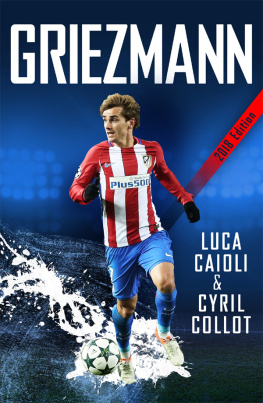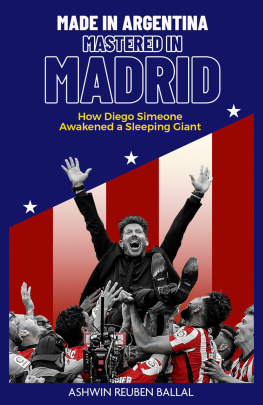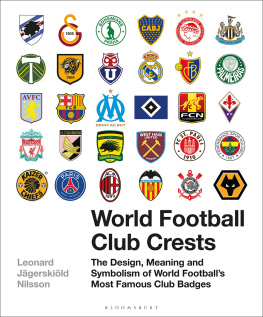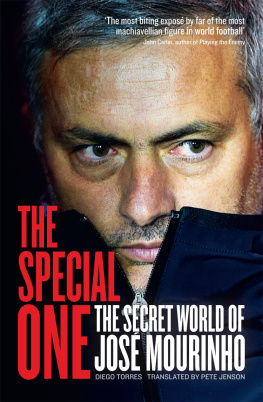DIEGO COSTA
THE ART OF WAR
First published in Great Britain in 2015 by
ARENA SPORT
An imprint of Birlinn Limited
West Newington House
10 Newington Road
Edinburgh
EH9 1QS
www.arenasportbooks.co.uk
Published in association with
BACKPAGE PRESS
www.backpagepress.co.uk
Copyright Fran Guilln, 2014, 2015
Translation Louise Hunter, 2015
ISBN: 978-1-909715-29-5
eBook ISBN: 978-0-85790-857-5
First published in Spain in 2014 by Al Poste Ediciones as Diego Costa : El Arte de la Guerra
The right of Fran Guilln to be identified as the author of this work has been asserted by him in accordance with the Copyright, Designs and Patents Act 1988.
All rights reserved. No part of this publication may be reproduced, stored, or transmitted in any form, or by any means electronic, mechanical or photocopying, recording or otherwise, without the express written permission of the publisher.
Every effort has been made to trace copyright holders and obtain their permission for the use of copyright material. The publisher apologises for any errors or omissions and would be grateful if notified of any corrections that should be incorporated in future reprints or editions of this book.
British Library Cataloguing-in-Publication Data A catalogue record for this book is available on request from the British Library.
Designed and typeset by Polaris Publishing, Edinburgh
Printed and bound by Clays St Ives
For my parents, without whom nothing would be possible
For all those who, like Diego, will not rest until they make their dreams come true
CONTENTS
CHAPTER 1
The Street Footballer
CHAPTER 2
The League of Honour
CHAPTER 3
Celta Vigo: The Good, the Bad and the Ugly
CHAPTER 4
Albacete: A City without a Beach
CHAPTER 5
Valladolid: Coming in from the Cold
CHAPTER 6
Atltico: The Breakthrough
CHAPTER 7
Rayo Vallecano: The Reprieve
CHAPTER 8
Atltico: Kings of the Bernabu
CHAPTER 9
Partido a Partido
CHAPTER 10
An International Incident
CHAPTER 11
Chelsea: Going to War
LIST OF ILLUSTRATIONS
.
.
.
.
.
.
.
.
.
.
.
.
.
.
.
.
.
.
.
.
.
.
.
.
.
.
.
.
PROLOGUE
SUMMER 2014. Cobham, 15 miles south-west of London. Chelseas training ground.
Oscar is looking for three of his team-mates. He wants to introduce them to someone. Diego Costa has arrived for his first day as a Chelsea player and he has something he wants to say. He doesnt have much English yet, but Oscar, a fellow Brazilian, has helped him with the words. Hes been practicing a single, short sentence. Actually, a mission statement.
The last time John Terry, Gary Cahill, Branislav Ivanovi and Nemanja Mati had seen Costa was at Stamford Bridge, as he shook their hands and left the pitch, on his way to the Champions League final after Atltico Madrids 3-1 victory over Chelsea.
Costa had won and scored the penalty that put his team 2-1 ahead, but in neither that match, nor the first leg of the semi-final, a 0-0 draw in the Spanish capital, had he been at his fearsome best. Chelseas muscular defence had certainly not been devastated by Costa. The trail of destruction he had cast across Spain in season 2013-14 had not stretched to England.
As Costa was substituted late on in London, the Chelsea fans sang: Diego Costa, well see you next year. The strikers next destination was no big secret.
But since then Costas stock had plummeted. A hamstring injury all but ended his participation in both the successfultitle run-in and the last-gasp defeat in the Champions League final. Then, at the World Cup, his sterile performances as Brazil jeered his every touch became one of the motifs of Spains abdication as world champions. Was this really the new Didier Drogba? Or just another in the long line of strikers who had failed to fill Drogbas boots at Chelsea?
Oscar introduces Terry, Cahill, Ivanovi and Mati to Diego Costa. They shake hands, then Costa straightens up and delivers his pitch in heavily-accented, halting English.
I go to war. You come with me.
Its funny, and they all laugh a little. But as the defenders head off to begin training, they share a look. They have found their man. Their warrior centre-forward.
It. Is. On.
THE STREET FOOTBALLER
Only one who is thoroughly acquainted with the evils of war is able to thoroughly understand the profitable way of carrying it out
Sun Tzu, The Art of War
DIEGO DA SILVA COSTA arrived in the world on October 7, 1988, in Lagarto, the third-largest city (with just over 100,000 inhabitants) in the state of Sergipe, north-east Brazil. His mother, Josileide Costa, was a nursery nurse, and his father, Jos de Jess Silva (aka Zeinha), was a farm worker and casual Sunday footballer who had always dreamed of having a player in the family. He also had two siblings: brother Jair (named after the Brazilian legend Jairzinho; Costa himself was named after Diego Maradona), and a sister, Talita.
Costas birthplace is known for cattle farming, some industry and agricultural production mainly oranges, tobacco and passion fruit. Nowadays you could almost call it a bustling metropolis. They built a university campus here and the city expanded as a result, explains Prefeitinho, Costas childhood friend. But back then it was much more rural.
The young Costa was a football obsessive from the very first, inspired by his father and uncles who refusedto accept that dreams could not become reality, even in a place like Lagarto.
It was a poor city and it would have been easy to moan about our lack of opportunities, says Prefeitinho. But Diego didnt think like that. He could easily have gone down the wrong track or at the very least given up on his early dreams. But he believed in his own potential. He knew what he wanted and he worked himself into the ground to get to where he wanted to go. He knew he was talented and he set out to prove it.
Costas first experience of football away from the street or the piece of land he played on at his grandparents house was the Boula de Ouro school, a social project which he now helps fund and which provides underprivileged kids with free training. Aged nine, he would set out on the 40-minute walk to the vacant wasteground where the rather chaotic sessions took place. Nowadays things are better organised and the school provides football training to 200 kids aged between eight and 17 who play on proper pitches provided by the local council.
Sometimes Costa cycled to football and on those occasions he would take along his equally football-mad neighbour Mrio Csar, who was speech-and-hearing impaired.
Diego insisted on bringing along this deaf and dumb kid, smiles Flvio Augusto Machado, Flavinho,his first coach who is still coaching today, with his whistle in his hand and an Atltico Madrid cap on his head. I wasnt happy and I said so. Mrio just couldnt understand what I said, but Diego was always there to translate for him.
In 2013, in a fitting tribute to their shared childhood experiences, Costa presented Mrio Csar with a motorbike.
The players warrior-like approach to football was evident from the first.











